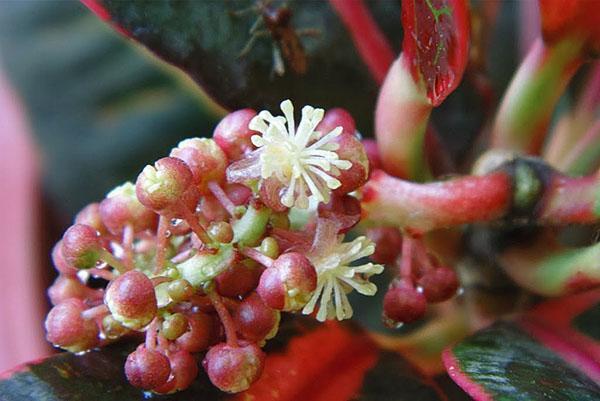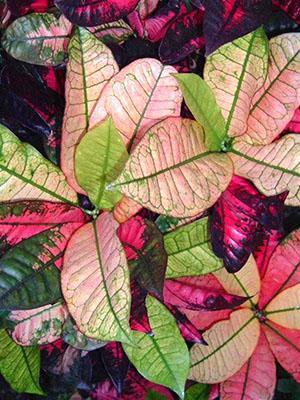When caring for Croton, consider his habits and preferences.
 Catchy variegated crotons, or how it is more correct to call these plants, codiaums got into the indoor collections of flower growers from the east of India, from other countries of south-east Asia, as well as from the American continent and from Australia. Lovers of bright exotic plants who have decided to "tame" Croton, when caring for this crop at home, should take into account its habits and preferences.
Catchy variegated crotons, or how it is more correct to call these plants, codiaums got into the indoor collections of flower growers from the east of India, from other countries of south-east Asia, as well as from the American continent and from Australia. Lovers of bright exotic plants who have decided to "tame" Croton, when caring for this crop at home, should take into account its habits and preferences.
In the wild, existing croton species can grow up to 3–4 meters in height. Indoor varieties are hybrid plants. They are not so tall, but they amaze with a variety of shapes and colors of dense leaves, densely growing on erect stems.
Depending on the variety, leaf plates can be elongated, elliptical, three-fingered, or have other outlines. There are ornamental plants with bizarrely twisted and wavy foliage. The color of croton leaves is no less varied. All shades of green, yellow, pink and purple, burgundy and brown are combined here in an amazing way. Large and small specks, stripes and stains are scattered over the leaves.

Croton care is aimed at making the plant feel good, and its leaves remain dense, juicy and multi-colored for a long time.
How to care for croton at home? What conditions for growth does this native of the fertile tropics need?
Features of the maintenance and care of Croton
Like other ornamental leafy crops from tropical regions, indoor crotons are extremely demanding and moody pets. Even with proper home care for croton, these plants:
- acclimatize for a long time after purchase or transplant;
- when the seasons change, they need to maintain a certain humidity and temperature.
 Most variegated species do well with long daylight hours and a fairly bright, but not scorching sun. In such conditions, the home croton is healthy and beautiful, its foliage retains the pattern and brightness inherent in the variety.
Most variegated species do well with long daylight hours and a fairly bright, but not scorching sun. In such conditions, the home croton is healthy and beautiful, its foliage retains the pattern and brightness inherent in the variety.
So that the rays of the sun do not harm the plant, it is better for the croton to find a place on the east or west windows, in the deep southern loggia. If there is only space on the south window, you will have to provide shading. On the north side, Croton will actively grow and retain its decorative effect only if artificial lighting.
The choice of a place for placing croton at home is not limited to caring for it. For Croton, warmth and adherence to seasonal temperature fluctuations is important.
On summer days, the plant does well at normal room temperature. Potted culture can and even should be taken out on the balcony, in the garden or on the veranda closed from the wind. The main thing is that when the weather worsens or at night, the thermometer does not drop below 13-14 ° C.
 In winter, caring for croton, as in the photo, at home involves keeping it at 18–20 ° C in a bright room without drafts and excessive dry air.
In winter, caring for croton, as in the photo, at home involves keeping it at 18–20 ° C in a bright room without drafts and excessive dry air.
If the air is cooled to 14 ° C and below, or at a temperature above 20 ° C, the plant suffers from a lack of lighting, croton will certainly make itself felt by stretching of shoots, wilting and loss of lower leaves.
The optimum room air humidity for croton is at least 45%.Excessive dryness of the atmosphere forces the grower to intensively care for the croton flower, in the photo, in order to prevent loss of foliage and even the death of the plant. First of all, such a danger is associated with heating operating in winter.
 To make life easier for a native of the tropics, you can use a household humidifier and periodically sprinkle croton with warm boiled water. Shower without touching the ground:
To make life easier for a native of the tropics, you can use a household humidifier and periodically sprinkle croton with warm boiled water. Shower without touching the ground:
- increases air humidity near the flower;
- helps to establish metabolic processes;
- improves the appearance of the plant.
In spring or summer, frequent spraying is not required. As part of regular care, Croton is only gently wiped with a damp cloth.
How to care for croton at home?
 From the beginning of spring and until autumn, Croton should not remain in conditions of a lack of moisture. During this period, the care of the croton flower, as in the photo, includes abundant watering, which is carried out when the soil surface dries.
From the beginning of spring and until autumn, Croton should not remain in conditions of a lack of moisture. During this period, the care of the croton flower, as in the photo, includes abundant watering, which is carried out when the soil surface dries.
In winter, the activity of the plant decreases, as does its need for moisture and nutrition. Therefore, croton has to be watered less often and less. After the top layer of the soil has dried, you can wait a couple more days and only then moisten the substrate. Usually, variegated foliage signals a moisture deficit, it loses its turgor and noticeably wilts.
 Vesta with watering in the summer Croton receives complex feeding, which include the main macro and micronutrients. You need to fertilize an ornamental culture every 2 weeks. And by winter, this procedure is stopped.
Vesta with watering in the summer Croton receives complex feeding, which include the main macro and micronutrients. You need to fertilize an ornamental culture every 2 weeks. And by winter, this procedure is stopped.
How to care for a croton flower, in the photo, if the plant has already completely occupied the volume of the pot and has become reluctant to give new shoots? Obviously, in such a situation, one cannot do without a transplant.
Although the ornamental culture does not like this procedure too much, it should be done for young crotons once every 1-2 years, and for adult specimens with an interval of 2-4 years, depending on the growth rate of the bush.
When there is no urgent need for a transplant, but the surface of the soil is covered with salts or is too compacted, it is better to carefully remove the top layer and, without disturbing the roots, add a new nutrient substrate.
As a soil mixture, you can use ready-made soil for large ornamental crops or for garden seedlings. Before planting, the substrate is steamed or otherwise sterilized, then fine expanded clay and crushed charcoal are added to it.
 To simplify the care of croton at home, medium-sized crop pots are chosen with a mandatory drainage hole to drain excess moisture.
To simplify the care of croton at home, medium-sized crop pots are chosen with a mandatory drainage hole to drain excess moisture.
I have such a flower I have 45 years old birthday on March 4 at my house the cat was interested in this plant
please tell me how to protect the plant from the cat
Many flower growers plant their favorite grass in a separate pot especially for cats, and some advise putting fresh tangerine skins in the pots. Try it, and suddenly it helps.
you probably want to say how to protect a cat from the croton plant. if he tries it, it will be the last thing he was interested in in his life
Thank you so much)))
Girls, tell me please, maybe you know what kind of flowers they are?
If the underside of the leaf is purple, then you have a wonderful calathea with narrow wavy leaves called rufibarba. She loves moderate watering, excess moisture and does not tolerate overdrying well. Demanding on air humidity, so the pot must be placed on a pallet with wet expanded clay. You have to be careful with fertilizing - the flower reacts badly to both a shortage and an excess of fertilizers. You can fertilize no more than twice a month, while reducing the recommended dosage by half.
Girls, tell me please, maybe you know the name of these flowers?
This is also a kind of calathea, judging by the coloring of the leaves, a variety of roseopicta Medallion. Loves partial shade and high humidity, will not survive the draft and cold.
Please tell me the name of this plant.
You have a variety of Croton, most of all the variety is similar to Champagne Splash.
Good day! Crotton Champagne splash has a problem, please tell me what to do? Thanks in advance. Photo is not loading. Leaves at the tips dry and fall off.
Croton leaves dry for many reasons. Maybe you will find your situation if you follow the link https://myvilla.decorexpro.com/en/pochemu-u-krotona-sokhnut-listya/.